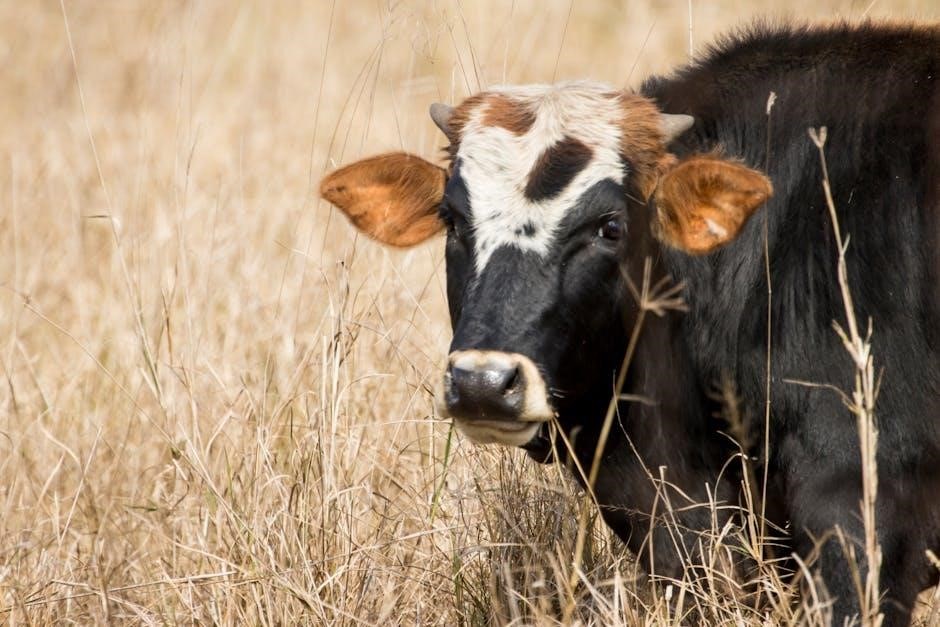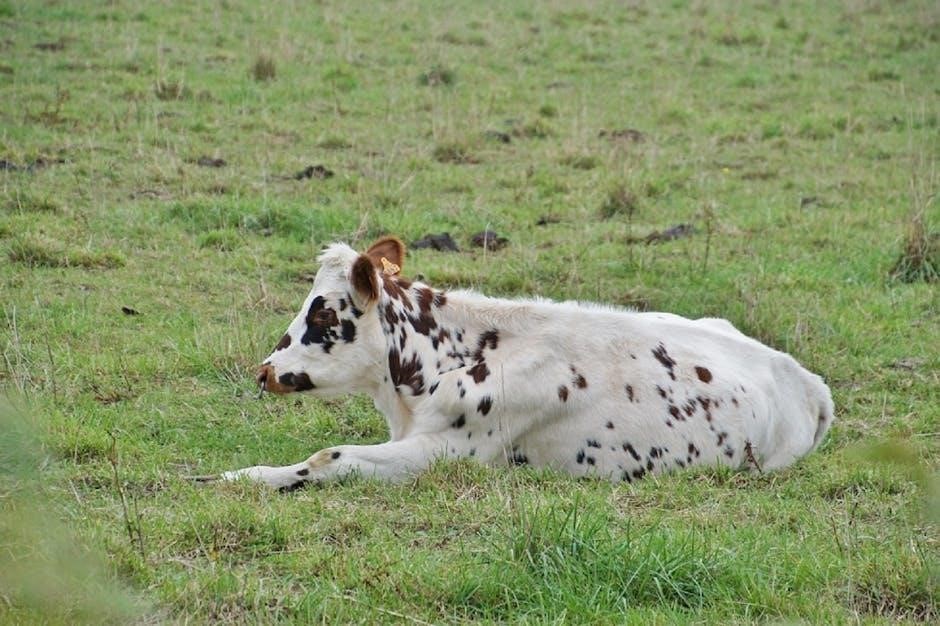LA-200 is a veterinary antibiotic used to treat bacterial infections in cattle․ Proper dosage ensures effectiveness and safety‚ making it crucial for cattle owners to follow guidelines․
What is LA-200?
LA-200 is a veterinary antibiotic containing 200 mg of oxytetracycline per ml‚ commonly used to treat bacterial infections in cattle and swine․ It is effective against diseases such as bacterial pneumonia and anaplasmosis․ The active ingredient‚ oxytetracycline‚ works by inhibiting protein synthesis in bacteria‚ thereby stopping their growth․ LA-200 is typically administered via intramuscular or subcutaneous injection‚ ensuring targeted delivery to combat infections․ Its formulation allows for sustained action‚ making it a reliable choice for livestock health management․ Proper dosage and administration are critical to ensure efficacy and prevent adverse effects․ LA-200 is widely recognized for its effectiveness in treating respiratory and systemic infections in cattle‚ making it a key tool in veterinary care․
Importance of Proper Dosage for Cattle
Proper dosage of LA-200 is critical for ensuring therapeutic effectiveness and minimizing risks to cattle․ Incorrect dosing can lead to reduced efficacy‚ potential toxicity‚ or the development of antibiotic resistance; Overdosing may cause adverse effects‚ such as liver or kidney damage‚ while underdosing can fail to control infections․ Accurate body weight assessment is essential to determine the correct dosage‚ as outlined in veterinary guidelines․ Additionally‚ adhering to the recommended dosage helps prevent residues in meat and ensures compliance with withdrawal periods before slaughter․ Proper dosing also supports animal welfare by optimizing treatment outcomes and reducing the risk of complications․ Veterinarians or experienced handlers should always administer LA-200 to ensure safety and efficacy․
Overview of LA-200
LA-200 is a long-acting oxytetracycline antibiotic used in veterinary medicine to treat bacterial infections in cattle and swine‚ including pneumonia and anaplasmosis․ It is administered intramuscularly or subcutaneously․
Active Ingredient and Mechanism of Action
The active ingredient in LA-200 is oxytetracycline‚ a broad-spectrum antibiotic belonging to the tetracycline class․ It works by binding to the 30S subunit of bacterial ribosomes‚ inhibiting protein synthesis and thereby preventing bacterial growth․ This mechanism is effective against a wide range of Gram-positive and Gram-negative bacteria․ Oxytetracycline is particularly potent against pathogens causing respiratory infections‚ making it a popular choice for treating conditions like bacterial pneumonia and anaplasmosis in cattle․ Its long-acting formulation ensures sustained therapeutic levels in the bloodstream‚ providing extended protection against infection․ This prolonged activity reduces the frequency of administration‚ enhancing convenience for livestock producers while maintaining efficacy․
Approved Uses in Veterinary Medicine
LA-200 is approved for use in cattle and swine to treat bacterial infections such as pneumonia and anaplasmosis․ In cattle‚ it is specifically indicated for bacterial pneumonia caused by Mannheimia haemolytica and Pasteurella multocida‚ as well as anaplasmosis caused by Anaplasma marginale․ For swine‚ it is effective against bacterial pneumonia caused by Pasteurella multocida․ The product contains oxytetracycline‚ which is administered intramuscularly or subcutaneously at a dose of 9 mg per pound of body weight․ Clinical trials have demonstrated its efficacy in reducing symptoms and improving recovery rates․ Proper administration ensures the drug’s effectiveness while minimizing the risk of adverse reactions․ Always follow veterinary guidelines for dosage and administration․

Dosage Calculation for Cattle
Dosage calculation for cattle involves administering 9 mg of LA-200 per pound of body weight‚ ensuring accurate measurement to avoid underdosing or overdosing․
General Dosage Recommendations
The recommended dosage of LA-200 for cattle is 9 mg of oxytetracycline per pound of body weight‚ administered via intramuscular or subcutaneous injection․ This ensures effective treatment of bacterial infections while minimizing risks․ The dosage should be calculated based on the animal’s accurate weight to avoid underdosing or overdosing․ For smaller animals‚ such as calves‚ the maximum volume per injection site should not exceed 10 mL‚ with 1-2 mL recommended for smaller sites․ It is crucial to follow these guidelines to ensure the drug’s efficacy and safety․ Proper administration and adherence to dosage recommendations are essential for treating conditions like bacterial pneumonia and anaplasmosis effectively in cattle․
Adjusting Dosage Based on Body Weight
The dosage of LA-200 for cattle should be adjusted according to the animal’s body weight to ensure optimal efficacy and safety․ The standard recommendation is 9 mg of oxytetracycline per pound of body weight․ For accurate dosing‚ the cattle’s weight should be determined precisely‚ using a scale if possible․ Heavier animals require a higher dosage‚ while lighter animals need a reduced amount․ For instance‚ a 1‚000-pound cow would require 9‚000 mg of oxytetracycline‚ equivalent to 45 mL of LA-200 (since each mL contains 200 mg)․ It’s important to adhere to maximum dosage limits to avoid adverse effects․ Additionally‚ the injection volume per site should not exceed 10 mL‚ with smaller volumes recommended for calves․ Always follow specific guidelines for younger animals to prevent overdose and ensure proper administration techniques․

Maximum Dosage Limits
The maximum recommended dosage of LA-200 for cattle is 9 mg of oxytetracycline per pound of body weight‚ ensuring safe and effective treatment․ Administration should not exceed 10 mL per injection site‚ with smaller volumes (1-2 mL) recommended for calves to prevent tissue damage․ The total dosage must not surpass the calculated amount based on the animal’s weight to avoid overdose․ Exceeding these limits can lead to adverse reactions or residues in meat․ Always adhere to the prescribed maximums and consult a veterinarian for guidance․ Proper dosing ensures both efficacy and animal safety while complying with regulatory standards․
Administration Methods
LA-200 is typically administered via intramuscular or subcutaneous injection․ The recommended dosage rate is 9 mg per pound of body weight․ Do not exceed 10 mL per injection site‚ with smaller volumes (1-2 mL) suggested for calves to prevent tissue irritation․ Always follow administration guidelines to ensure safety and efficacy․
Intramuscular Injection Guidelines

LA-200 should be administered intramuscularly‚ typically in the neck area‚ at a dosage of 9 mg per pound of body weight․ Ensure the injection site is clean to prevent infection․ Do not exceed 10 mL per injection site; for smaller animals‚ such as calves‚ limit to 1-2 mL per site to minimize discomfort․ Administer once daily as prescribed․ Always use sterile needles and syringes to maintain hygiene․ Avoid injecting more than the recommended volume to prevent tissue damage․ Consult a veterinarian if unsure about the proper technique or volume․ Proper administration ensures efficacy and reduces the risk of adverse reactions․

Subcutaneous Administration
Subcutaneous administration of LA-200 is an alternative method‚ offering ease of use for cattle owners․ The recommended dosage remains 9 mg per pound of body weight․ Inject under the skin‚ ensuring the area is clean to minimize infection risk․ Unlike intramuscular injections‚ subcutaneous administration may cause local swelling but is generally well-tolerated․ Avoid exceeding 10 mL per injection site to prevent tissue irritation․ For smaller animals like calves‚ reduce the volume per site to 1-2 mL․ Administer once daily as prescribed․ Always use sterile equipment to maintain safety․ Subcutaneous injections can be less stressful for animals compared to intramuscular methods‚ making it a viable option for routine treatment․ Consult a veterinarian if unsure about the technique or volume․
Oral Administration (if applicable)
Oral administration of LA-200 for cattle is not the standard method‚ as the product is typically formulated for intramuscular or subcutaneous use․ However‚ in some cases‚ oral dosing may be considered‚ particularly for pigs‚ where the recommended dose is 23 mg per pound or 0․11 mL per pound of body weight․ For cattle‚ oral administration is less common due to potential issues with bioavailability and absorption․ If oral administration is deemed necessary‚ consult a veterinarian for specific guidance․ Always ensure the correct dosage is calculated based on the animal’s weight to avoid underdosing or overdosing․ Proper administration techniques and adherence to withdrawal periods are critical for safety and efficacy․ Never administer orally without professional advice․

Safety and Precautions
LA-200 should not be administered to weak or debilitated animals․ Withdrawal period before slaughter is at least 28 days․ Avoid exceeding maximum dosage limits to prevent adverse reactions․
Contraindications for Cattle
LA-200 is contraindicated in cattle with known hypersensitivity to oxytetracycline or other tetracyclines․ It should not be administered to weak‚ debilitated‚ or dehydrated animals due to increased risk of adverse reactions․ Additionally‚ LA-200 is not recommended for cattle with severe renal or hepatic impairment‚ as it may exacerbate existing conditions․ Pregnant or lactating cattle should only receive LA-200 under veterinary guidance to minimize potential risks to the fetus or calves․ Concurrent use with other antibiotics or medications should be avoided unless directed by a veterinarian to prevent drug interactions․ Always adhere to the recommended dosage to ensure safety and efficacy in cattle․
Common side effects of LA-200 in cattle include injection site reactions such as swelling‚ redness‚ or pain․ Gastrointestinal issues like diarrhea or decreased appetite may also occur‚ particularly with oral administration․ In rare cases‚ more severe adverse reactions such as allergic responses‚ including anaphylaxis‚ can happen․ Prolonged use or overdosing may lead to the development of antibiotic resistance or disruption of the animal’s natural microbiota․ Weak or debilitated animals are at higher risk of adverse effects․ Monitoring for any unusual symptoms is crucial‚ and treatment should be discontinued immediately if severe reactions occur․ Always follow the recommended dosage to minimize the risk of side effects and ensure the drug’s efficacy․ The withdrawal period for LA-200 in cattle is 28 days before slaughter to ensure no antibiotic residues remain in the meat․ This period is critical to comply with food safety regulations and prevent illegal residues․ Proper adherence to the withdrawal period helps maintain consumer safety and prevents potential legal issues․ Always follow the recommended withdrawal time to ensure compliance with veterinary and regulatory guidelines․ Consulting the product label or a veterinarian for specific instructions is strongly advised to avoid any violations․ This ensures the meat is safe for consumption and meets all required standards․ LA-200 is effective against bacterial infections‚ acting quickly to reduce symptoms․ Its duration of action typically lasts several days‚ ensuring sustained relief for treated cattle․ LA-200 has proven highly effective against various bacterial infections in cattle‚ including pneumonia and anaplasmosis․ Its active ingredient‚ oxytetracycline‚ inhibits bacterial protein synthesis‚ halting infection progression․ Clinical trials demonstrate its efficacy at the recommended dosage of 9 mg per pound of body weight‚ administered intramuscularly or subcutaneously․ The antibiotic works rapidly to reduce fever and improve respiratory symptoms‚ making it a reliable choice for treating bacterial diseases․ However‚ its effectiveness may vary based on the severity of infection and timely administration․ Proper dosage calculation is critical to ensure optimal therapeutic results and prevent under or overtreatment․ Always follow veterinary guidance for the best outcomes in cattle health․ LA-200 exhibits a prolonged duration of action‚ typically lasting 24 to 48 hours‚ allowing for once-daily dosing in cattle․ This extended activity ensures sustained antibacterial effects‚ supporting the recovery of infected animals․ The withdrawal period for slaughter is 28 days‚ reflecting the time required for the drug to clear the system․ Factors such as infection severity and individual animal health may influence the duration of effectiveness․ Proper administration and adherence to dosage guidelines are essential to maximize the antibiotic’s activity and ensure therapeutic success․ Always follow veterinary recommendations to maintain efficacy and safety in cattle treatment․ The efficacy of LA-200 in cattle is influenced by several factors‚ including accurate body weight determination‚ proper administration technique‚ and adherence to dosage recommendations․ Overdosing or underdosing can reduce effectiveness or lead to adverse reactions․ The injection site and method also play a role‚ with intramuscular administration generally preferred for optimal absorption․ Additionally‚ the animal’s overall health‚ liver and kidney function‚ and the severity of infection impact drug performance․ Ensuring the correct treatment duration and avoiding exceeding maximum dosage limits are critical for maintaining therapeutic effectiveness․ Proper handling and storage of the product‚ as well as compliance with withdrawal periods‚ further ensure its efficacy and safety in cattle․ Special considerations for LA-200 dosage include proper storage‚ handling‚ and disposal to maintain potency and environmental safety․ Dosing must be adjusted for calves versus adult cattle․ Dosing LA-200 varies between calves and adult cattle to ensure effectiveness and safety․ Calves typically require a lower dosage due to their smaller body weight‚ while adult cattle need higher doses to combat infections effectively․ The recommended dosage for calves is 9 mg of oxytetracycline per pound of body weight‚ administered intramuscularly or subcutaneously․ For adult cattle‚ the same dosage applies but must be adjusted based on their larger body mass․ It’s crucial to avoid exceeding the maximum injection volume of 10 mL per site‚ with smaller volumes recommended for calves to prevent tissue damage․ Proper dosing ensures optimal therapeutic effects while minimizing potential side effects․ Proper handling and storage of LA-200 are essential to maintain its efficacy and safety․ The product should be stored at room temperature‚ protected from light and moisture‚ and not frozen․ It is ready to use and does not require mixing with other solutions․ Shake the bottle thoroughly before administration to ensure the solution is uniform․ Avoid contamination of the product by using a clean needle and syringe for each administration․ LA-200 should not be used after its expiration date‚ and unused portions should be disposed of according to local regulations․ Proper handling ensures the drug remains effective and prevents potential environmental contamination․ Always follow the manufacturer’s guidelines for storage and disposal․ Environmental and safety precautions are critical when handling LA-200 to prevent contamination and ensure safe use․ The product should be disposed of properly‚ avoiding disposal in waterways or soil‚ as it may harm aquatic life or contaminate the environment․ Use protective clothing‚ gloves‚ and eyewear to minimize exposure․ In case of accidental skin or eye contact‚ wash thoroughly with water․ If ingested‚ seek medical attention immediately․ Prevent pets and wildlife from accessing the product or treated animals․ Follow local regulations for disposal and handling of veterinary pharmaceuticals․ Proper precautions protect both human health and the environment‚ ensuring responsible use of antibiotics like LA-200․ Always refer to the manufacturer’s safety guidelines for comprehensive instructions․ Proper LA-200 dosage for cattle ensures safety and efficacy․ Always follow guidelines and consult a veterinarian to avoid adverse effects and promote effective treatment outcomes․ The recommended dosage of LA-200 for cattle is 9 mg of oxytetracycline per pound of body weight‚ administered intramuscularly or subcutaneously․ Ensure accurate weight assessment to avoid under or over-dosing․ Administer no more than 10 mL per injection site‚ with smaller volumes for calves․ Treat once daily‚ continuing for 48 hours after symptoms subside․ Withdraw treatment 28 days before slaughter to comply with meat safety regulations․ Always follow manufacturer instructions and consult a veterinarian for specific guidance․ Proper dosing maximizes effectiveness and minimizes risks of adverse reactions․ Adherence to these guidelines ensures safe and effective treatment of bacterial infections in cattle․ Cattle owners should strictly adhere to the recommended dosage of 9 mg of oxytetracycline per pound of body weight for LA-200․ Administer intramuscularly or subcutaneously‚ ensuring accurate weight assessment to avoid under or over-dosing․ Limit injection volume to 10 mL per site‚ using smaller amounts for calves․ Continue treatment for 48 hours after symptoms resolve․ Discontinue use 28 days before slaughter to meet withdrawal requirements․ Always follow the manufacturer’s guidelines and consult a veterinarian for tailored advice․ Proper dosing and administration practices are essential to ensure efficacy and safety‚ minimizing the risk of adverse reactions․ By following these guidelines‚ cattle owners can effectively treat bacterial infections while maintaining animal health and food safety standards․ Relevant studies‚ clinical trials‚ and manufacturer guidelines provide detailed information on LA-200 dosage recommendations for cattle․ These sources ensure accurate and safe administration practices․ Studies demonstrate that LA-200‚ containing oxytetracycline‚ is effective for treating bacterial infections in cattle at a dosage of 9 mg per pound of body weight․ Clinical trials have shown its efficacy against conditions like bacterial pneumonia and anaplasmosis․ Proper administration methods‚ such as intramuscular injection‚ ensure optimal absorption and effectiveness․ Research emphasizes the importance of accurate body weight measurement to avoid underdosing or overdosing․ Maximum injection volume per site should not exceed 10 mL to prevent tissue damage․ These findings are supported by manufacturer guidelines and veterinary recommendations‚ ensuring safe and effective treatment outcomes for cattle․ Adherence to these protocols is critical for maintaining animal health and preventing antibiotic resistance․ The manufacturer recommends a dosage of 9 mg of oxytetracycline per pound of body weight for cattle‚ administered intramuscularly or subcutaneously․ The product label specifies that each mL contains 200 mg of oxytetracycline‚ simplifying dosage calculations․ For accurate dosing‚ body weight should be determined as precisely as possible․ The maximum injection volume at any single site is 10 mL‚ with smaller volumes recommended for calves․ Manufacturer guidelines also emphasize a 28-day withdrawal period before slaughter to ensure food safety․ Adherence to these guidelines is essential for both efficacy and safety‚ preventing adverse reactions and ensuring compliance with regulatory standards․ Proper handling and storage instructions are also provided to maintain product potency․Side Effects and Adverse Reactions
Withdrawal Period Before Slaughter
Efficacy and Duration of Action

Effectiveness Against Bacterial Infections
Duration of Antibiotic Activity
Factors Affecting Drug Efficacy

Special Considerations
Dosing for Calves vs․ Adult Cattle
Handling and Storage of LA-200
Environmental and Safety Precautions
Final Recommendations for Cattle Owners

References

Relevant Studies and Clinical Trials
Manufacturer Guidelines and Documentation
Manufacturer Guidelines and Documentation



